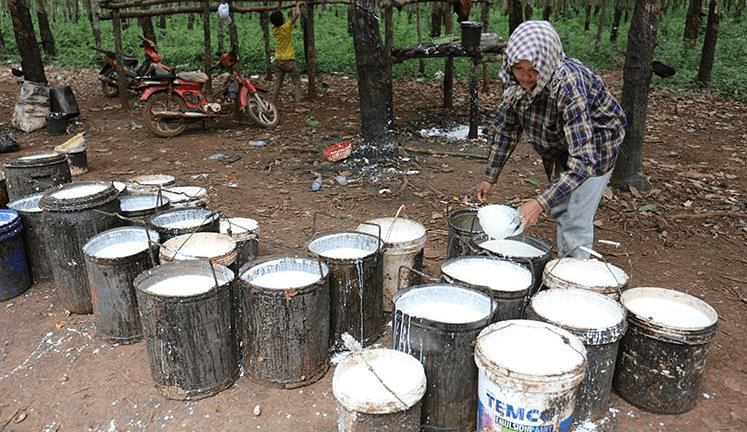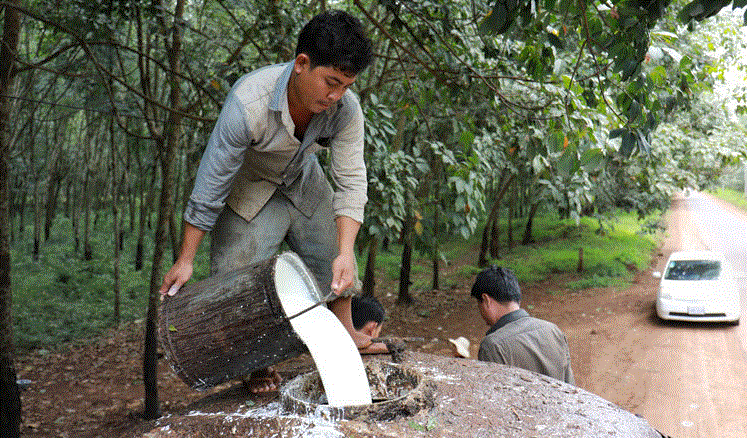
In the context of the global decrease in demand, Cambodia earned $121 million from rubber exports in the first month of this year, a 123.5% increase compared to the same period last year, according to the latest trade data from the General Department of Customs and Excise (GDCE) under Cambodia’s Ministry of Economy and Finance.
The data shows that the upward trend in Cambodia’s rubber exports started in the second half of 2022, continued throughout last year, and extended into January this year.
In 2023, Cambodia’s rubber and rubber products exports reached $919 million, a 69.6% growth compared to the previous year. The major importing markets include China, Vietnam, Malaysia, Singapore, India, and the European Union (EU).
Globally, according to the Association of Natural Rubber Producing Countries (ANRPC) based in Kuala Lumpur, global natural rubber production in December 2023 increased by 9.1% to reach 1.5 million tons. Meanwhile, global natural rubber demand in December 2023 decreased by 3.2% to 1.2 million tons, according to ANRPC Secretary-General Heng Guan. Therefore, diversifying rubber export markets becomes more important.
In the past year, Thailand was the world’s largest natural rubber producer, followed by Indonesia, Vietnam, China, India, Malaysia, and Cambodia.
Vietnam’s rubber exports in 2023 reached 2.14 million tons, valued at $2.89 billion, a 0.1% decrease in volume and a 12.8% decrease in value compared to 2022. The average export price of rubber in 2023 was significantly lower than in 2022, reaching $1,350 per ton, a 12.7% decrease compared to the average export price in 2022.
After a decline in the past year, Vietnam’s rubber exports showed positive growth in the beginning of 2024, with exports in January 2024 reaching about 260,000 tons, valued at $365 million, a 92.6% increase in volume and a 99.8% increase in value compared to January 2023, according to data from the General Department of Customs. The average export price of rubber in January 2024 was $1,404 per ton, a 0.9% increase compared to December 2023 and a 3.7% increase compared to January 2023…
China continues to be the world’s largest consumer of natural rubber, followed by India, Thailand, and Malaysia.
In 2023, the global natural rubber market is estimated to reach 14.69 million tons, while consumption is projected to be around 14.738 million tons.
According to experts, in 2024, the natural rubber market will continue to face significant economic obstacles, especially due to slower-than-expected growth in the world’s second-largest economy – China – in the second quarter of this year. China is the world’s largest tire producer.
In addition, the prolonged impacts of the Russia-Ukraine and Israel-Hamas conflicts and the high borrowing costs as central banks worldwide raised interest rates in the past few years to combat inflation.
As a result, natural rubber prices in the international market decreased by nearly 15% last year. In fact, in the first 8 months of 2023, the average rubber price in Cambodia was $1,327 per ton, a decrease of $230 per ton compared to the same period the previous year.
Heng Guan, Secretary-General of ANRPC, said: “Persistent inflation and the global economic recovery in 2023 are major concerns.”
According to Cambodia’s Ministry of Agriculture, Forestry, and Fisheries, in 2021, the country had over 400,000 hectares of rubber plantation. Cambodia also has 168 rubber processing factories and handicraft centers in 11 provinces.

Cambodian rubber workers.
According to ANRPC data, Kampong Thom is the leading rubber-producing province in Cambodia, with rubber plantation area accounting for 15.4% of the country’s total rubber-covered area, followed by Mondulkiri (8.4%) and Stung Treng (4.2%).
While the country used to export almost all of its natural rubber production a few years ago, the launch of some tire manufacturing plants, especially by Chinese companies last year, has led to increased demand for raw rubber in the domestic market.
Chinese companies, the world’s largest tire producer and exporter, have started building additional plants overseas to meet the market demand that is recovering after the country reopened following the Covid-19 pandemic.
China’s annual tire production accounts for more than half of the global total production. However, recently, many companies have begun building factories overseas, especially in Cambodia, a major rubber producer, to take advantage of low production costs.
Recently, in early February 2024, one of the first companies to be launched in the UK, General Tire Technology (Cambodia), started operations at a $300 million factory in Sihanoukville Economic Zone (SSEZ) in Cambodia.
The factory has the capacity to produce 5 million steel-belted radial tires and 900,000 all-steel radial tires per year. The factory is located in Preah Sihanouk province in Cambodia and is a subsidiary of the Chinese tire manufacturer General Science Technology from Guangdong province. The tires produced at this factory are mainly exported to the US, Europe, and Brazil.
China’s Doublestar Tire Company has also started building a $200 million factory in Kratie Economic Zone with an annual production capacity of 8.5 million radial tires.
Recently, Cart Tire Co Ltd, the largest modern tire manufacturer in China operating on behalf of Sailun Group, launched the first car tire produced in Cambodia under the brand name ‘Sailun’. According to the company’s source, the factory in Svay Rieng province can produce up to 35,000 tires per day in the initial stage. They also plan to build two more factories in Cambodia.
With these realities, it will be difficult for Cambodia’s rubber exports to maintain a rapid pace of growth in the near future.
Reference: khmertimeskh












